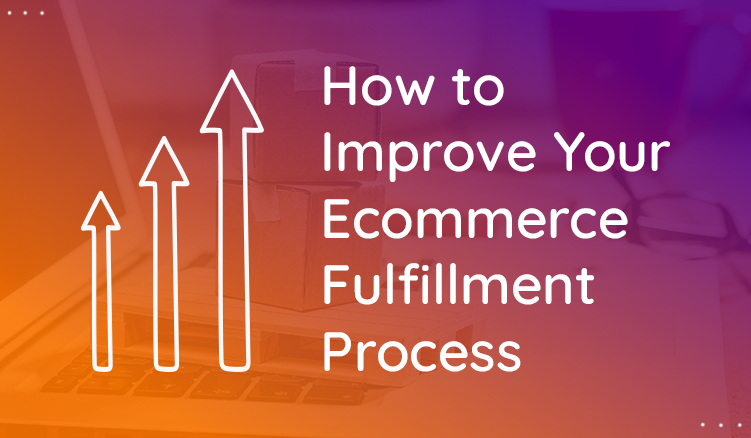Easy Ways to Improve Your Ecommerce Fulfillment Process

Keep the good stuff coming
Subscribe to our blog newsletter and get monthly content that helps you manage product data smarter.
No spam. Just real value.
No matter how stellar your products or sales operations are, the ecommerce fulfillment process has the potential to make or break your business.
Customers have high standards for delivery speeds and order accuracy, and faltering here can lead to more refunds and fewer return visits. So, here are five ways to improve your ecommerce fulfillment process and keep customers happy.
1. Introduce another check
Improving order accuracy offers compounding benefits to your ecommerce fulfillment process. Getting more correct orders out the door can reduce returns and reverse logistics, protect revenue, and minimize the amount of work your warehouse team has. This means that customers will be happier, and you’re able to better position yourself to generate more recurring revenue.
Barcode scanners are mobile, whether that’s a smartphone app or a separate device, and can easily move around a warehouse. Use them to scan products as they’re packed, and tie this to your order management system. It’ll help ensure that the pickers grab the right products in the correct quantities for each order. To add, you can further improve accuracy by having your packing stations verify the goods in each order through a high-tech scanning system. Packers get an order from within a system and then individually scan every product in that order.
In many instances, this will replace a visual check and counting that your team already does. The benefit of this is that they can scan all the goods and get a confirmation, so any interruption is less likely to make them start all over again.
2. Walk around your warehouse
Fulfillment processes are naturally grounded in physical activities and a lot of movement. People, equipment, products, packaging, and more are all in constant motion in your warehouse. Observing the flow of each group may help you identify bottlenecks or efficiency opportunities. Walk through your warehouse and use any inventory tools available to track as much movement as you can.
There are many standard best practices to adopt. However, you might also find nuances relevant to your business. For example, most warehouses and fulfillment centers benefit by moving the highest-selling goods closest to packing stations. This change generally speeds up order picking because orders with only top sellers involve much less walking.
Depending on your products, you may discover a more significant benefit if you adjust this layout but keep that same principle. Say that Product A and Product B are your top sellers but are rarely purchased together. Placing these on different ends of the aisles closest to packing stations still gives you that speed boost thanks to proximity and avoids congestion as multiple people try to pick goods from the same part of a shelf or aisle.
If products are similar, having them in bins next to each other may lead to more mis-picks or incorrect barcode scans. Put yourself in the role of the picker as you do this walkthrough. See where you can avoid congestion and confusion.
3. Employing PIM for better inventory management
As ecommerce grows, so do the tools available. One solution that’s helping many is product information management (PIM) systems. The discussion of these tools often focuses on marketing and website updates, but they play a role in broader inventory management and fulfillment as well. A PIM makes it easy to update product information across all your assets and sales channels. For instance, you can use PIM software to update the image of a product and push that out to your sales pages on your website and multiple marketplaces.
Your shoppers are always looking at a clear show of what’s in your warehouse. This prevents them from looking at last year’s design, so they’re getting the color and style they expect. It’ll reduce return rates and can keep your reviews more positive. A PIM also makes it easier to track performance. It can identify a new product that gets a lot of views but zero purchases. That could mean you need to reintroduce it, for example, creating a sample-size version as a free gift. Let PIM data help guide your warehouse activities when looking at layout and labor.
Sign up here or download our FREE guide to choosing the right PIM!
4. Communicate more with customers
Ecommerce communications serve a variety of purposes, and they’re almost always good. The more you reach out to your customers, the better your chances of building trust and deepening the relationship. Move beyond the simple “thank you” messaging and engage with customers throughout your fulfillment process.
The goal is to make this simple. Automate your message delivery by integrating inventory tools and your CRM. Notify a customer when a transaction is processed and provide shipping estimates. When order ships, send out a notice and include tracking details if they’re not part of your first email. Follow-up with a customer when a package is expected to arrive. A final communication in these campaigns is to task about the process and product, sticking to a few questions total.
Customers will thank you for being proactive, especially if you alert them to a delay. This gives you a chance to apologize ahead of time and provide an update. The customer avoids the frustration of not having their package arrive on time and then having to ask you about it. Communication adds value to your interactions and improves how the customer feels about your specific fulfillment process.
The caveat here is to use your data and systems to inform conversations. Look for ways to improve the intelligence of your system and the entire messaging plan. For example, you can tell that a package is delayed and notify the customer through automation. That knowledge should also lead to you delaying any requests for a review until the package has arrived. You won’t frustrate customers by asking about a product they have not yet received
5. Give returns their place
Returns are expected in ecommerce, which means they’ll play a role in your overall fulfillment processes. According to recent data, shoppers return about 30% of what they buy online, but roughly 92% say easy returns make them more likely to buy from you again. It’s a significant opportunity for businesses of all sizes.
Allowing returns and their potential boost in overall sales will increase the labor demand in your warehouse. As products return, they need to be checked to determine if you can resell the inventory. Improper reviews can put damaged products back on your shelves, likely causing another return or refund down the road. Prevent this by giving returns their own space in your warehouse.
While you’ll receive returns in the same location as your inbound inventory freight, returns should get their own tables for review. Creating that space allows you or staff to clearly check and confirm that a product is returned appropriately or meets your requirements. Adding a workstation will enable your team to scan returns into your system as soon as they’re approved, speeding up the process to refund customers or start their replacement order.
The more you streamline the process, the faster it’ll go. That can improve how your customers view your returns process.
Outsource if things get too hard
The final thought to leave you with is that fulfillment is a core business process. Your business needs to get it right to be able to control costs, manage expectations, and keep customers happy. When the process becomes too overwhelming or you can’t afford to scale up to the size you need, look for partners. Many third-party logistics companies offer fulfillment services designed to offer two-day shipping to your customers at affordable rates.
They’ll use the latest technologies and best practices to control expenses across operations. These companies can provide guarantees for accuracy and order speed while often cutting your shipping costs because they can negotiate volume-based rates with carriers. It takes daily action to keep fulfillment running smoothly, and not every company has the time or expertise to manage that in-house.
Outsourcing is helpful if you’re struggling because it takes the pressure off leadership teams while also making it easier for you to satisfy customers through reliable service. And your business gets all the credit when fulfillment goes right because a 3PL will brand all shipments with your logo, packaging, and more.

Jake Rheude
Jake Rheude is the Vice President of Marketing at Red Stag Fulfillment, an ecommerce fulfillment warehouse that was born out of ecommerce. He has years of experience in ecommerce and business development. In his free time, Jake enjoys reading about business and sharing his own experience with others.

What if your product data actually worked for you?
We’ll show you how Plytix helps you stop fixing data—and start using it.
Related posts
Keep the good stuff coming
Subscribe to our blog newsletter and get monthly content that helps you manage product data smarter.
No spam. Just real value.





Think others should see this?
Go ahead and share it.